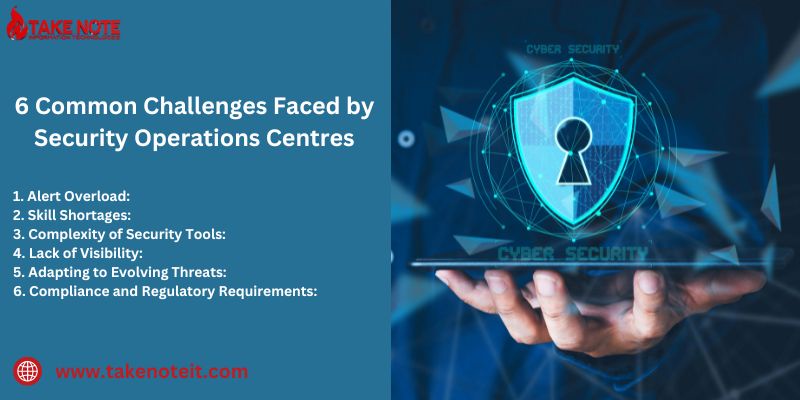Security Operations Centre (SOCs) are like watchdogs for computer systems. They keep a close eye on networks, looking out for any signs of trouble or threats. They use special tools and techniques to monitor, detect, and respond to cyber attacks or breaches. Think of them as guardians that work round-the-clock to protect digital information, like passwords, personal data, and company secrets. SOCs analyze patterns and behaviors in data traffic to spot anything unusual, helping to keep computers and networks safe from hackers and cyber criminals. They're an essential part of keeping the digital world secure and running smoothly.
Security Operations Centers (SOCs) play a crucial role in safeguarding organizations against cyber threats. However, they encounter various challenges in their day-to-day operations.
Let's Delve Into Six Common Challenges Faced By Security Operations Centre And Explore Ways To Address Them:
1. Alert Overload:
One of the biggest challenges for SOCs is dealing with an overwhelming number of alerts generated by security tools. This flood of alerts can lead to alert fatigue, where analysts may miss critical indicators of compromise amidst the noise.
Implementing automation and orchestration can help prioritize and streamline alerts. Utilizing advanced analytics and machine learning algorithms can also aid in identifying genuine threats while reducing false positives.
2. Skill Shortages:
The cybersecurity industry faces a shortage of skilled professionals, including analysts with expertise in threat detection and incident response. This scarcity makes it challenging for SOCs to recruit and retain qualified personnel.
Invest in training and upskilling programs for existing staff to enhance their capabilities. Collaborating with educational institutions and promoting cybersecurity as a career option can help attract new talent to the field.
3. Complexity of Security Tools:
SOCs often utilize a multitude of security tools from different vendors, each with its own interface and set of features. Managing and integrating these tools can be complex and time-consuming.
Adopting unified security platforms that consolidate multiple functions into a single interface can simplify operations for SOC analysts. Integration through standardized protocols and APIs can also facilitate seamless communication between different tools.
4. Lack of Visibility:
Limited visibility into the organization's entire IT infrastructure poses a significant challenge for SOCs. Without comprehensive visibility, analysts may struggle to detect threats across networks, endpoints, and cloud environments.
Implementing network and endpoint monitoring solutions can enhance visibility into the organization's assets and activities. Leveraging technologies such as intrusion detection systems (IDS) and endpoint detection and response (EDR) platforms can provide real-time insights into potential security incidents.
5. Adapting to Evolving Threats:
Cyber threats are constantly evolving, with attackers employing sophisticated techniques to bypass traditional security measures. SOCs must stay abreast of the latest threat intelligence and continuously adapt their defense strategies.
Establishing robust threat intelligence programs can help SOCs proactively identify emerging threats and vulnerabilities. Collaboration with industry peers and participation in information sharing communities can also provide valuable insights into evolving attack trends.
6. Compliance and Regulatory Requirements:
Meeting compliance mandates and regulatory requirements is another challenge faced by SOCs, particularly in highly regulated industries such as finance and healthcare. Failure to comply with these regulations can result in severe financial penalties and reputational damage. Implementing robust governance, risk, and compliance (GRC) frameworks can help ensure adherence to relevant regulations and standards. Automating compliance processes and conducting regular audits can streamline compliance efforts and demonstrate due diligence to regulators.
Imagine trying to find a specific book in a library without a catalog. SOCs face a similar challenge with data overload. They collect vast amounts of security data from various sources. Analyzing this data manually is overwhelming and time-consuming. Without proper tools and processes, important indicators of compromise can go unnoticed.
Conclusion:
Security Operations Centers play a vital role in protecting organizations from cyber threats. However, they encounter several challenges that can hinder their effectiveness. From alert overload to skill shortages, these obstacles require proactive solutions. By addressing these challenges, SOCs can better defend against evolving cyber threats and ensure the security of the organizations they protect.
SOCs encounter numerous challenges in their mission to protect organizations from cyber threats, proactive measures can help mitigate these challenges. By leveraging technology, investing in talent development, enhancing visibility, staying informed about emerging threats, and prioritizing compliance, SOCs can strengthen their defenses and safeguard critical assets effectively.


No comments yet